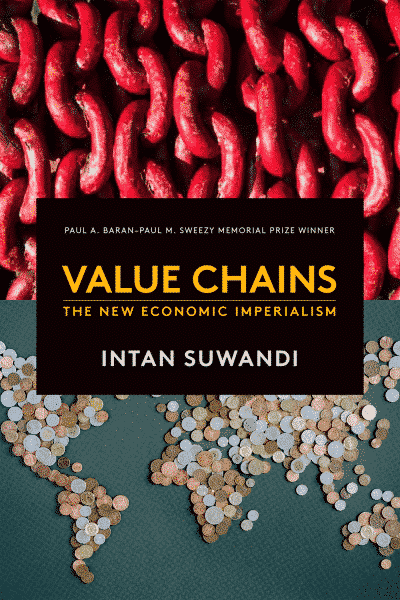Value Chains:
The New Economic Imperialism
By Intan Suwandi
216 pages, 978-1-58367-781-0, $23
Reviewed by Michael Keaney for the Review of Radical Political Economics
During the last 30 years the business school curriculum has increasingly incorporated courses dealing with practices such as operations management, logistics, and purchasing that have come to be grouped under the rubric of supply chain management (Melnyk, Stank, and Closs 2000; Croom, Romano, and Giannakis 2000). Whole degree programs and academic research agendas have followed, to the extent that there is no longer argument concerning the subject area’s status as an academic discipline. This is a reflection of the enhanced significance of supply chain governance (Gereffi 2014) resulting from the global reconfiguration of supply chains that was already accelerating during the 1980s, such that we are now in an age of “supply chain capital- ism” (Tsing 2009).
It is not as if companies previously did not engage in the management of operations, logistics, and purchasing. Indeed, management guru Peter Drucker recognized the underappreciated relevance of logistics well in advance of these developments (Drucker 1962). It was with the expansion of US-based multinational corporations, which “appeared to be learning how to use their subsidiaries in the less developed areas as part of an international logistical system” such that they became “logistical points in an international network” (Vernon 1971: 501), that business supply chain operations, broadly conceived, began to assume greater analytical and practical prominence.
Lenin’s concept of an imperialist chain was developed by Nicos Poulantzas, who portrayed a global system of national social formations subject to uneven development (Poulantzas 1975: 42–50). The world in this schema is “an interconnected set of nodes. . . defined at the political and ideological levels as well as at the economic level” (Gerstein 1977: 17). The hierarchical and exploitative nature of imperialism as it had evolved by then was mapped out, as was its focus: “The international imperialist division of labour is thus related above all to the social division and organization of the entire labour process” (Poulantzas 1975: 66).
Nevertheless, lately Marxist scholarship has seen the recurrence of what might be called a “denialist” view of imperialism as “obsolete” due to the weakening of “nation-states as the primary form of political organization of world capitalism” (Arrighi 2002: 18; see also Hardt and Negri 2000). Earlier authors employed Marxist concepts to argue that higher wages in the core countries were due to superior productivity (Charles Bettelheim), and that imperialism was in fact a pioneer of Third World development (Bill Warren). More recently John Smith has challenged David Harvey’s “refusal to acknowledge that production outsourcing to low-wage countries signifies a vast expansion of direct and indirect super-exploitation of Southern labor by US, European, and Japanese TNCs,” with Harvey arguing instead “that this transformation marks the passing of imperialism not its apogee” (Smith 2016: 202; for a summary of the debate, see Higginbottom 2018). Recently published findings regarding Fortune 500 financial firms’ political action committees’ donations to the campaigns of congressional candidates who favor military intervention in developing countries in defense of investments there suggest otherwise (Lee, Florea, and Blarel 2019). Imperialism, even in more familiar garb (in this case akin to the “gunboat diplomacy” practiced by the British), has yet to pass.
Building on Smith’s work is Intan Suwandi’s very timely and important study of global value chains (GVCs), also known as global commodity chains and global production networks in the various specialist literatures dealing with the worldwide restructuring of capitalist production already identified by Vernon and Poulantzas. Suwandi incorporates Smith’s specific insights relating to GVCs into a Baran-Sweezy “Monopoly Capital” theoretical framework in which the tendency toward monopoly generates a crisis of surplus absorption, to which the response of capital is imperialist expansion. For Suwandi, the imperialist aspect is especially manifest in the geography of labor exploitation, whereby “the difference in wages between the North and South is greater than the difference in productivity” (17).
Suwandi is a native of Indonesia, and as the title of the final chapter of her book states, she is looking at GVCs through the eyes of the Global South, where “the persistence of the hierarchical world economy…is recognized by all classes” (13). Indeed, the use of the chain metaphor is particularly apposite. Chains are both linkages and instruments of bondage.
The “imperialist chain” identified by Poulantzas has exactly this dual character, and this is brought to the fore by Suwandi most effectively in her empirical contribution, which comprises two case studies of Indonesian companies that compete for contracts awarded by Western multinational corporations (MNCs), which are themselves lead firms at the head of GVCs. By conducting extended inter- views with the managers of these companies, she gains insights regarding the pressures placed upon such firms by their oligopsonistic customers, in addition to how their labor processes are managed and their workers super-exploited.
Suwandi employs a concept of “labor-value (commodity) chains,” which is the chief theoretical contribution of the book. Around this concept a framework is developed “to operationalize exploitation within the labor theory of value” and “empirically operationalized through the examination of unit labor costs” (18). Labor value chains “involve a form of unequal exchange based on a worldwide hierarchy of wages, in which global capital (firms headquartered in the Global North) captures value from the South” (20). In this way what might be termed the mechanics of value extraction, within a governance framework that is imperialist due to its administration and enforcement of the coerced exaction of tribute, all backed by state power, are more thoroughly illuminated.
Following Smith (2016: 177–186), she exposes the transparently mythical link between wages and productivity that sustains much orthodox and denialist discourse, whose absurd claims regarding the superior productivity of workers in the Global North are used to justify wage differentials are debunked. Official data “show that countries with the highest participation in labor- value chains—the top three being China, India, and Indonesia—also have very low unit labor costs” (18). This means that, in addition to low wages, the productivity of workers in those countries is high. This is obscured by official recourse to purchasing power parity currency rates, as opposed to market values of labor costs “that largely determine the overall profit margins of multinationals” (58). This is compounded by gross domestic product’s (GDP) inclusion of market transactions, as opposed to use values. In this way official statistics facilitate the enabling mythology of the wages-productivity link and “value-added” that purports to “explain” the concentration of value extraction at the head of the value chain as appropriate reward for “value added” (orthodoxy) or as the result of greater exploitation of workers in the Global North (denialist Marxism).
Crucial to understanding what is really going on is the practice of “labor arbitrage.” Suwandi reiterates Smith’s exposition of the labor theory of value in the context of globally mobile capital alongside severely restricted labor, whose very lack of freedom of movement obstructs the “iron law of wages” from taking effect. The result is a global system utterly loaded in favor of capital, and which capital duly exploits, to the extent of super-exploiting primarily the workers of the Global South.
Capital also super-exploits workers in the Global North, as was recently revealed with respect to UK fast-fashion brand Boohoo’s use of clothing factories based in Leicester, England, whose “exploitative work practices that might have helped spread coronavirus in the city” caused a minor scandal (Barker and Eley 2020). However, the scale of such super-exploitation pales in comparison. The political outcry that such doorstep discoveries trigger is in stark contrast to the regimes of the Global South, where very well-documented horrors, including the notorious Rana Plaza catastrophe of 2013 in Bangladesh, have little impact on the retailers that are at the head of the GVCs served by local manufacturers driven by those retailers to cut their costs as low as possible (Kazmin 2018).
The practicalities of such relationships are revealed in Suwandi’s case studies, in which she conducts extended interviews with management and observes work practices. For analytical purposes, she employs the concept of systemic rationalization developed by German industrial sociologists, in addition to Harry Braverman’s classic work (Braverman 1974). The former aims at control of the commodity chain “through supra-national company regulation of functions such as R&D, logistics and quality management” (74, quoting Altmann and Deiss 1998: 139). The Taylorist organization of work that was Braverman’s focus applies to the control of labor processes exercised not only by local management but also via the supra-national GVC governance mechanisms that are ultimately traceable to lead firms’ demands, even when apparently originating elsewhere.
In addition to more direct interventions, such as lead firms’ dictation of supplier firms’ profit margins (121), lead firms’ use of “open-cost systems” that give them direct access to suppliers’ cost structures (120), or just the kudos for supplier firms of having large MNCs as customers (118), there are indirect interventions, such as those resulting from corporate social responsibility (CSR) campaigns that attempt to shame lead firms into raising employment standards. These often involve third-party certification of supplier firms’ factory premises, which allows lead firms plausible deniability, given their ability to play off competing supplier firms against each other (134). The supplier firms will go to great lengths to reconcile demands for better labor conditions with their need for lower labor costs, just as they do with the contradictory demands of quality assurance and flexibility forced upon them by the lead firms, often resulting in waste (127). The imperialist chain, or “supra-national GVC governance structure,” works to ensure that supplier margins are as tight as practically possible, making such waste an unwelcome reminder of supplier firms’ precarity. Meanwhile, claims regarding the humanization of work and elimination of alienation are fantasy in a context of Taylorist work practices administered in repressive regimes that host large reserve armies of labor (150).
Most campaigning on behalf of better labor standards in the Global North has been conducted using a CSR focus (Milberg and Winkler 2013: 305). The futility of this was most recently exposed by the Boohoo scandal. The growing popularity of investment funds profiled as focused on firms that adhere to supposedly strict environmental, social and governance (ESG) standards has caused embarrassment for investment rating providers that had ranked Boohoo highly on ESG criteria. As a result some of the approximately 20 ESG funds that invested in Boohoo have since “rushed to offload stakes” (Mooney and Nilsson 2020). As if the shock of finding super-exploitative working conditions in the fast fashion industry were not enough, there had already been a detailed exposé of labor practices in these factories 2 years earlier in the Financial Times (O’Connor 2018).
Suwandi alights on Stephen Marglin’s (1974) argument concerning the “putting-out system” in early capitalism, whereby textile workers worked according to the capitalist’s specifications with their own tools at home, but in such a way that “no single workers produced the entire product” (84–85). The factory system extended this de-skilling and reduction of worker autonomy by taking control of the worker’s labor, and the same logic continues to drive the off- shoring and outsourcing (“putting-out”) that is characteristic of our era, underlining the prescience of Poulantzas’ argument cited above, and the relevance of Suwandi’s book.
Value Chains should be read by anyone with an interest in the practicalities of offshoring, outsourcing, and supply chain management. It should also be required reading for those who fail to recognize actually existing imperialism.
You can find the above at Review of Radical Political Economics


Comments are closed.